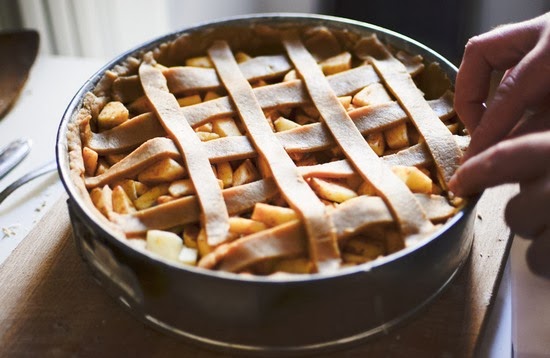 |
| A try-out for the apple-pie / Una prova per fare la torta |
On Sunday the 16th of February I will be a participant of the European Restaurant Day. As Food in the Streets I open my house to everyone who feels like eating a piece of delicious apple pie (with wipped-cream, if you like) and a cup of coffee or tea.
Restaurant Day is organized four times a year in 30 different European countries spread over almost 200 cities. As explained on the website it is
"....a food carnival created by thousands of people organizing and visiting one-day restaurants worldwide. The idea of the day is to have fun, share new food experiences and enjoy our common living environments together. "
Every restaurant is free to choose what to serve (breakfast, lunch, aperitivo, etc) and to ask a compensation from the guests.
This time Food in the Streets offers a so called merenda (from 16 to 18 o'clock) for which I ask a donation of five euros per person to cover the costs. While you are enjoying the pie we can have a chat about the projects I am doing here in Milan, for example the soon to be launced Old Milano Food Tour.
Don't forget to sign-up so that I can send you all the details foodinthestreets [at] gmail. [dot] com
Stay tuned for updates by following Food in the Streets on Facebook.
-----------------------------------------------------------------------------------------------------------
La domenica 16 febbraio parteciperò al Restaurant Day. Come Food in the Streets aprirò la casa mia a tutti colori che hanno voglia di godersi una fetta di torta di mele (con panna montata a piacere) e una tazza di caffè o te caldo.
Restaurant Day è un evento organizzato quattro volte al anno. Si svolge in 30 paese Europe, in circa 200 città. Come spiegano sul sito:
"Il Giorno del Ristorante è un carnevale culinario formato dalle migliaia di persone che organizzano o che vanno a mangiare in uno dei ristoranti che nascono in tutto il mondo per un giorno soltanto. L’idea è quella di divertirsi, condividere nuove esperienze culinarie e godere insieme agli altri degli spazi in cui viviamo la nostra quotidianità. L’evento è facilitato da un gruppo di volontari che, tra le altre cose, mantengono questo sito. Ogni ristoratore è personalmente responsabile di tutte le azioni legate alla gestione del proprio ristorante."
Ogni ristoratore è libero di scegliere quello che voglia offrire (colazione, pranzo, aperitivo, ecc.) e decidere di chiedere un'offerta dei visitatori.
Questa volta Food in the Streets offrirà una merenda (dalle h16 alle h18) per quale chiedo una offerta di cinque euro a testa per coprire le spese. Mentre tu stai godendo la torta possiamo chiacchierare sui progetti che sto facendo qui a Milano, per esempio il Old Milano Food Tour, che presenterò presto al pubblico.
Se vuoi venire a case mia per goderti una merenda speciale ti chiedo di avvisarmi tramite mail. Poi ti manderò tutti i dettagli per arrivare a casa mia foodinthestreets [at] gmail. [dot] com
Per rimanere aggiornata, segui Food in the Streets sulla pagina di Facebook.


